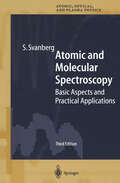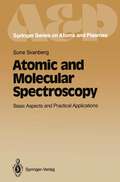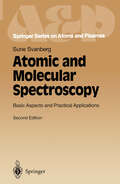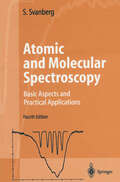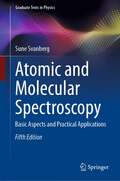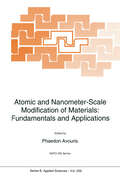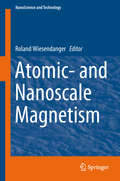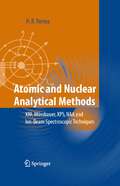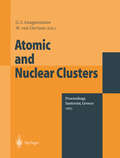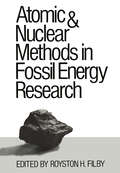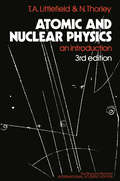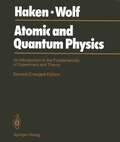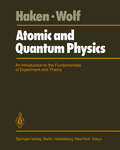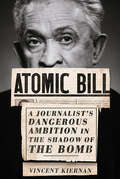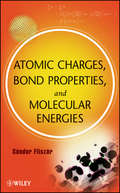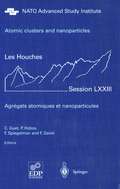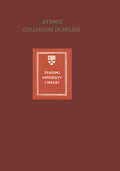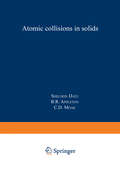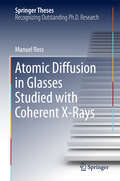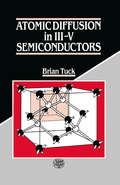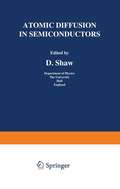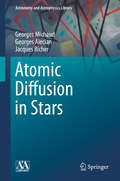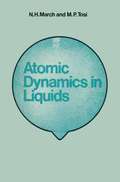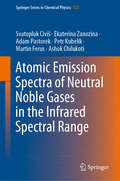- Table View
- List View
Atomic and Molecular Spectroscopy: Basic Aspects and Practical Applications (Springer Series on Atomic, Optical, and Plasma Physics #6)
by Sune SvanbergA wide-ranging review of modern spectroscopic techniques such as X-ray, photoelectron, optical and laser spectroscopy, and related techniques. The book focuses on physical principles and the impact of spectroscopy on our understanding of the building blocks of matter, while examining applications to chemical analysis, photochemistry, surface characterization, environmental and medical diagnostics, remote sensing, and astrophysics. This Third Edition includes the most up-to-date developments.
Atomic and Molecular Spectroscopy: Basic Aspects and Practical Applications (Springer Series on Atomic, Optical, and Plasma Physics #6)
by Sune SvanbergAtomic and molecular spectroscopy has provided basic information leading to the development of quantum mechanics and to the understanding of the building blocks of matter. It continues to provide further insight into the statics and dynamics of the microcosmos, and provides the ·means for test ing new concepts and computational methods. The results of atomic and molecular spectroscopy are of great importance in astrophysics, plasma and laser physics. The rapidly growing field of spectroscopic applications has made considerable impact on many disciplines, including medicine, envi ronmental protection, chemical processing and energy research. In particu lar, the techniques of electron and laser spectroscopy, the subjects of the 1981 Nobel prize in physics, have contributed much to the analytical poten tial of spectroscopy. This textbook on Atomic and Molecular Spectroscopy has been pre pared to provide an overview of modern spectroscopic methods. It is in tended to serve as a text for a course on the subject for final-year under graduate physics students or graduate students. It should also be useful for students of astrophysics and chemistry. The text has evolved from courses on atomic and molecular spectroscopy given by the author since 1975 at Chalmers University of Technology and at the Lund Institute of Technol ogy. References are given to important books and review articles which of different aspects of atomic and molecular allow more detailed studies spectroscopy. No attempt has been made to cover all important references, nor have priority aspects been systematically considered.
Atomic and Molecular Spectroscopy: Basic Aspects and Practical Applications (Springer Series on Atomic, Optical, and Plasma Physics #6)
by Sune SvanbergA wide-ranging review of modern techniques in atomic and molecular spectroscopy. A brief description of atomic and molecular structure is followed by the relevant energy structure expressions. A discussion of radiative properties and the origin of spectra leads into coverage of X-ray and photoelectron spectroscopy, optical spectroscopy, and radiofrequency and microwave techniques. The treatment of laser spectroscopy investigates various tunable sources and a wide range of techniques characterized by high sensitivity and high resolution. Throughout this book, the relation between fundamental and applied aspects is shown, in particular by descriptions of applications to chemical analysis, photochemistry, surface characterisation, environmental and medical diagnostics, remote sensing and astrophysics.
Atomic and Molecular Spectroscopy: Basic Aspects and Practical Applications (Advanced Texts in Physics)
by Sune SvanbergA wide-ranging review of modern spectroscopic techniques such as X-ray, photoelectron, optical and laser spectroscopy, and radiofrequency and microwave techniques. On the fundamental side the book focuses on physical principles and the impact of spectroscopy on our understanding of the building blocks of matter, while in the area of applications particular attention is given to those in chemical analysis, photochemistry, surface characterisation, environmental and medical diagnostics, remote sensing and astrophyscis. The Fourth Edition also provides the reader with an update on laser cooling and trapping, Bose-Einstein condensation, ultra-fast spectroscopy, high-power laser/matter interaction, satellite-based astronomy and spectroscopic aspects of laser medicine.
Atomic and Molecular Spectroscopy: Basic Aspects And Practical Applications (Springer Series On Atomic, Optical, And Plasma Physics Ser. #6)
by Sune SvanbergAtomic and Nanometer-Scale Modification of Materials: Fundamentals and Applications (NATO Science Series E: #239)
by P. AvourisThis volume contains the proceedings of the conference on "Atomic and Nanometer Scale Modification of Materials: Fundamentals and Applications" which was co-sponsored by NATO and the Engineering Foundation, and took place in Ventura, California in August 1992. The goal of the organizers was to bring together and facilitate the exchange of information and ideas between researchers involved in the development of techniques for nanometer-scale modification and manipulation. theorists investigating the fundamental mech anisms of the processes involved in modification, and scientists studying the properties and applications of nanostructures. About seventy scientists from all over the world participated in the conference. It has been more than 30 years since Richard Feynman wrote his prophetic article: ''There is Plenty of Room at the Bottom" (Science and Engineering, 23, 22, 1960). In it he predicted that some day we should be able to store bits of information in structures composed of only 100 atoms or so, and thus be able to write all the information accumulated in all the books in the world in a cube of material one two-hundredths of an inch high. He went on to say, "the prin ciples of physics, as far as I can see, do not speak against the possibility of maneuvering things atom by atom. " Since that time there has been significant progress towards the realization of Feynman's dreams.
Atomic- and Nanoscale Magnetism (NanoScience and Technology)
by Roland WiesendangerThis book provides a comprehensive overview of the fascinating recent developments in atomic- and nanoscale magnetism, including the physics of individual magnetic adatoms and single spins, the synthesis of molecular magnets for spintronic applications, and the magnetic properties of small clusters as well as non-collinear spin textures, such as spin spirals and magnetic skyrmions in ultrathin films and nanostructures. Starting from the level of atomic-scale magnetic interactions, the book addresses the emergence of many-body states in quantum magnetism and complex spin states resulting from the competition of such interactions, both experimentally and theoretically. It also introduces novel microscopic and spectroscopic techniques to reveal the exciting physics of magnetic adatom arrays and nanostructures at ultimate spatial and temporal resolution and demonstrates their applications using various insightful examples. The book is intended for researchers and graduate students interested in recent developments of one of the most fascinating fields of condensed matter physics.
Atomic and Nuclear Analytical Methods: XRF, Mössbauer, XPS, NAA and Ion-Beam Spectroscopic Techniques
by Hem Raj VermaThis book compares and offers a comprehensive overview of nine analytical techniques important in material science and many other branches of science. All these methods are already well adapted to applications in diverse fields such as medical, environmental studies, archaeology, and materials science. This clearly presented reference describes and compares the principles of the methods and the various source and detector types.
Atomic and Nuclear Clusters: Proceedings of the Second International Conference at Santorini, Greece, June 28 – July 2, 1993
by G. S. Anagostatos W. V. OertzenThe Second International Conference on Atomic and Nuclear Clusters '93 was orga nized in a joint effort by the 'Demokritos' National Center for Scientific Research, G. S. Anagnostatos (representing the atomic physics) and the Hahn-Meitner-Institut, W. von Oertzen (representing the nuclear physics). The subject of clusters - small aggregates of particles - is a topic of primary interest in both atomic and nuclear physics, and also in other fields like in the case of quark-structure of baryons and in cosmology. The interplay between atomic and nuclear physics is a particularly fascinating one because many concepts are common to both fields (quantal effects, shells, geometric structures, collective modes, fission etc. ) This conference was the second after the first one organized by Professor M. Brenner in Abo (Finland) in 1991. The general atmosphere of a joint forum for atomic and nuclear physicists was very fruitful and thus the decision to have a sequence of such meetings has been taken. A third one is planned in St. Petersburg (Russia) with Professor K. Gridnev (St. Petersburg) and Mme. Professor C. Bnkhignac (Orsay) as Chairpersons. The conference site, Fin\. on Santorini island (Greece), was a wonderful choice for a conference. It is small, which helps to keep people concentrated in a smaller community, it has a perfect convention center, the P. Nomikos Conference Center, and a very beautiful landscape formed by a large volcanic crater.
Atomic and Nuclear Physics: An Introduction
by Thomas Albert LittlefieldAfter the death of Dr. Littlefield it was decided that I should undertake the revision ofthe whole of Atomic and Nuclear Physics: an Introduction for the third edition, and it was soon apparent that major changes were necessary. I am confident that these changes would have had Dr. Littlefield's approval. The prime consideration for the present edition has been to modernize at a minimum cost. As much as possible of the second edition has therefore been retained, but where changes have been made they have been fairly drastic. Thus the chapters on fine structure, wave mechanics, the vector model of the atom, Pauli's principle and the Zeeman effect have been completely restructured. The chapters on nuclear models, cosmic rays, fusion systems and fundamental particles have been brought up to date while a new chapter on charm and the latest ideas on quarks has been included. It is hoped that the presentation of the last named will give readers a feeling that physics research can be full of adventure and surprises.
Atomic and Quantum Physics: An Introduction to the Fundamentals of Experiment and Theory
by Hermann Haken Hans C. WolfAtomic physics and its underlying quantum theory are the point of departure for many modern areas of physics, astrophysics, chemistry, biology, and even electrical engineering. This textbook provides a careful and eminently readable introduction to the results and methods of empirical atomic physics. The student will acquire the tools of quantum physics and at the same time learn about the interplay between experiment and theory. A chapter on the quantum theory of the chemical bond provides the reader with an introduction to molecular physics. Plenty of problems are given to elucidate the material. The authors also discuss laser physics and nonlinear spectroscopy, incorporating latest experimental results and showing their relevance to basic research. Extra items in the second edition include solutions to the exercises, derivations of the relativistic Klein-Gordon and Dirac equations, a detailed theoretical derivation of the Lamb shift, a discussion of new developments in the spectroscopy of inner shells, and new applications of NMR spectroscopy, for instance tomography.
Atomic and Quantum Physics: An Introduction to the Fundamentals of Experiment and Theory
by Hermann Haken H.C. WolfA thorough knowledge of the physics of atoms and quanta is clearly a must for every student of physics but also for students of neighbouring disciplines such as chemistry and electrical engineering. What these students especially need is a coherent presenta tion of both the experimental and the theoretical aspects of atomic and quantum physics. Indeed, this field could evolve only through the intimate interaction between ingenious experiments and an equally ingenious development of bold new ideas. It is well known that the study of the microworld of atoms caused a revolution of physical thought, and fundamental ideas of classical physics, such as those on measur ability, had to be abandoned. But atomic and quantum physics is not only a fascinating field with respect to the development of far-reaching new physical ideas. It is also of enormous importance as a basis for other fields. For instance, it provides chemistry with a conceptual basis through the quantum theory of chemical bonding. Modern solid-state physics, with its numerous applications in communication and computer technology, rests on the fundamental concepts first developed in atomic and quantum physics. Among the many other important technical applications we mention just the laser, a now widely used light source which produces light whose physical nature is quite different from that of conventional lamps. In this book we have tried to convey to the reader some of the fascination which atomic and quantum physics still gives a physicist studying this field.
Atomic Bill: A Journalist's Dangerous Ambition in the Shadow of the Bomb
by Vincent KiernanIn Atomic Bill, Vincent Kiernan examines the fraught career of New York Times science journalist, William L. Laurence and shows his professional and personal lives to be a cautionary tale of dangerous proximity to power. Laurence was fascinated with atomic science and its militarization. When the Manhattan Project drew near to perfecting the atomic bomb, he was recruited to write much of the government's press materials that were distributed on the day that Hiroshima was obliterated. That instantly crowned Laurence as one of the leading journalistic experts on the atomic bomb. As the Cold War dawned, some assessed Laurence as a propagandist defending the militarization of atomic energy. For others, he was a skilled science communicator who provided the public with a deep understanding of the atomic bomb. Laurence leveraged his perch at the Times to engage in paid speechmaking, book writing, filmmaking, and radio broadcasting. His work for the Times declined in quality even as his relationships with people in power grew closer and more lucrative. Atomic Bill reveals extraordinary ethical lapses by Laurence such as a cheating scandal at Harvard University and plagiarizing from press releases about atomic bomb tests in the Pacific. In 1963 a conflict of interest related to the 1964 World's Fair in New York City led to his forced retirement from the Times. Kiernan shows Laurence to have set the trend, common among today's journalists of science and technology, to prioritize gee-whiz coverage of discoveries. That approach, in which Laurence served the interests of governmental official and scientists, recommends a full revision of our understanding of the dawn of the atomic era.
Atomic Charges, Bond Properties, and Molecular Energies
by Sandor FliszarThe first book to cover conceptual quantum chemistry, Atomic Charges, Bond Properties, and Molecular Energies deftly explores chemical bonds, their intrinsic energies, and the corresponding dissociation energies, which are relevant in reactivity problems. This unique first-hand, self-contained presentation develops relatively uncomplicated but physically meaningful approaches to molecular properties by providing derivations of all the required formulas from scratch, developed in Professor Fliszar's laboratory. This book is vitally relevant to organic- and biochemists, molecular biologists, materials scientists, and nanoscientists.
Atomic clusters and nanoparticles. Agregats atomiques et nanoparticules: Les Houches Session LXXIII 2-28 July 2000 (Les Houches - Ecole d'Ete de Physique Theorique #73)
by C. Guet P. Hobza F. Spiegelman F. DavidFocused on basic science, this book reviews experiments on metal clusters in two long pedagogically written articles. Interested readers will also find articles ranging from density functional theory to computer simulations of cluster dynamics.
Atomic Diffusion in Glasses Studied with Coherent X-Rays (Springer Theses)
by Manuel RossThis thesis provides the first successful study of jump diffusion processes in glasses on the atomic scale, utilizing a novel coherent technique. This new method, called atomic-scale X-ray Photon Correlation Spectroscopy or aXPCS, has only recently been proven to be able to capture diffusion processes with atomic resolution in crystal systems.With this new toolkit for studying atomic diffusion in amorphous systems, new insight into basic processes in a wide range of technically relevant materials, like fast ionic conductors, can be obtained.
Atomic Diffusion in III-V Semiconductors
by Brian TuckIII-V semiconductors, of which gallium arsenide is the best known, have been important for some years and appear set to become much more so in the future. They have principally contributed to two technologies: microwave devices and optoelectronics. Recent advances in the production of thin layers have made possible a whole new range of devices based on multi-quantum wells. The heat treatments used in the manufacture of semiconductor devices means that some diffusion must take place. A good understanding of diffusion processes is therefore essential to maintain control over the technology. Atomic Diffusion in III-V Semiconductors presents a lucid account of the experimental work that has been carried out on diffusion in III-Vs and explores the advanced models that explain the results. A review of the III-V group of semiconductors outlines the special properties that make them so attractive for some types of devices. Discussion of the basic elements of diffusion in semiconductors provides the theory necessary to understand the subject in depth, and the book gives hints on how to assess the published data. Chapters on diffusion of shallow donors, shallow acceptors, transition elements, and very fast-diffusing elements provide a critical review of published works. The book also presents the neglected subject of self-diffusion, including a section on superlattices. Atomic Diffusion in III-V Semiconductors will be of interest to research workers in semiconductor science and technology, and to postgraduate students in physics, electronics, and materials science.
Atomic Diffusion in III-V Semiconductors
by Brian TuckIII-V semiconductors, of which gallium arsenide is the best known, have been important for some years and appear set to become much more so in the future. They have principally contributed to two technologies: microwave devices and optoelectronics. Recent advances in the production of thin layers have made possible a whole new range of devices based on multi-quantum wells. The heat treatments used in the manufacture of semiconductor devices means that some diffusion must take place. A good understanding of diffusion processes is therefore essential to maintain control over the technology. Atomic Diffusion in III-V Semiconductors presents a lucid account of the experimental work that has been carried out on diffusion in III-Vs and explores the advanced models that explain the results. A review of the III-V group of semiconductors outlines the special properties that make them so attractive for some types of devices. Discussion of the basic elements of diffusion in semiconductors provides the theory necessary to understand the subject in depth, and the book gives hints on how to assess the published data. Chapters on diffusion of shallow donors, shallow acceptors, transition elements, and very fast-diffusing elements provide a critical review of published works. The book also presents the neglected subject of self-diffusion, including a section on superlattices. Atomic Diffusion in III-V Semiconductors will be of interest to research workers in semiconductor science and technology, and to postgraduate students in physics, electronics, and materials science.
Atomic Diffusion in Semiconductors
by D. ShawThe diffusion or migration of atoms in matter, of whatever form, is a basic consequence of the existence of atoms. In metals, atomic diffusion has a well established position of importance as it is recognized that there are few metallurgical processes which do not embody the diffusion of one or more of the constituents. As regards semiconductors any thermal annealing treatment involves atomic diffusion. In semiconductor technology diffusion processes provide a vital and basic means of fabricating doped structures. Notwithstanding the importance of diffusion in the preparative processes of semiconductor structures and samples, the diffusion based aspects have acquired an empirical outlook verging almost on alchemy. The first attempt to present a systematic account of semiconductor diffusion processes was made by Boltaks [11 in 1961. During the decade since Boltaks' book appeared much work germane to understanding the atomic mechanisms responsible for diffusion in semiconductors has been published. The object of the present book is to give an account of, and to consolidate, present knowledge of semiconductor diffusion in terms of basic concepts of atomic migration in crystalline lattices. To this end, exhaustive compilations of empirical data have been avoided as these are available elsewhere [2, 31 : attention has been limited to considering evidence capable of yielding insight into the physical processes concerned in atomic diffusion.
Atomic Diffusion in Stars (Astronomy and Astrophysics Library)
by Georges Michaud Georges Alecian Jacques RicherThe authors give an overview of atomic diffusion as applied to all types of stars, showing where it plays an essential role and how it can be implemented in modelling. Part I describes the tools that are required to include atomic diffusion in models of stellar interiors and atmospheres. An important role is played by the gradient of partial radiative pressure, or radiative acceleration, which is usually neglected in stellar evolution. In Part II, the authors systematically review the contribution of atomic diffusion to each evolutionary step. The dominant effects of atomic diffusion are accompanied by more subtle effects on a large number of structural properties throughout evolution. The goal of this book is to provide the means for the astrophysicist or graduate student to evaluate the importance of atomic diffusion in a given star. A fundamental physical process, atomic diffusion can significantly affect the superficial abundances of stars and/or their evolution. This guide includes all the information needed to take proper account of atomic diffusion's impact.
Atomic Emission Spectra of Neutral Noble Gases in the Infrared Spectral Range (Springer Series in Chemical Physics #122)
by Svatopluk Civiš Ekaterina Zanozina Adam Pastorek Petr Kubelík Martin Ferus Ashok ChilukotiThis book is an invaluable guide to calibrating any infrared spectrum using noble gases as a reference. Featuring a detailed graphical and tabular overview of highly excited (Rydberg) states of neutral noble gases in the infrared range of 700–7000 cm-1, it helps researchers by providing high-precision experimental data that can be used in almost every infrared spectroscopic laboratory.
